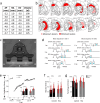Expectancy-related changes in firing of dopamine neurons depend on hippocampus
- PMID: 39414794
- PMCID: PMC11484966
- DOI: 10.1038/s41467-024-53308-z
Expectancy-related changes in firing of dopamine neurons depend on hippocampus
Abstract
The orbitofrontal cortex (OFC) and hippocampus (HC) both contribute to the cognitive maps that support flexible behavior. Previously, we used the dopamine neurons to measure the functional role of OFC. We recorded midbrain dopamine neurons as rats performed an odor-based choice task, in which expected rewards were manipulated across blocks. We found that ipsilateral OFC lesions degraded dopaminergic prediction errors, consistent with reduced resolution of the task states. Here we have repeated this experiment in male rats with ipsilateral HC lesions. The results show HC also shapes the task states, however unlike OFC, which provides information local to the trial, the HC is necessary for estimating upper-level hidden states that distinguish blocks. The results contrast the roles of the OFC and HC in cognitive mapping and suggest that the dopamine neurons access rich information from distributed regions regarding the environment's structure, potentially enabling this teaching signal to support complex behaviors.
© 2024. This is a U.S. Government work and not under copyright protection in the US; foreign copyright protection may apply.
Conflict of interest statement
The authors declare no competing interests.
Figures







Update of
-
Expectancy-related changes in firing of dopamine neurons depend on hippocampus.bioRxiv [Preprint]. 2023 Jul 21:2023.07.19.549728. doi: 10.1101/2023.07.19.549728. bioRxiv. 2023. Update in: Nat Commun. 2024 Oct 16;15(1):8911. doi: 10.1038/s41467-024-53308-z. PMID: 37781610 Free PMC article. Updated. Preprint.
References
-
- O’Keefe J., Nadel L. The Hippocampus as a Cognitive Map. Clarendon Press (1978).
-
- Eichenbaum, H. Hippocampus: mapping or memory? Curr. Biol.10, R785–R787 (2000). - PubMed
-
- Tolman, E. C. Cognitive maps in rats and men. Psychological Rev.55, 189–208 (1948). - PubMed
-
- Behrens, T. E. et al. What is a cognitive map? organizing knowledge for flexible behavior. Neuron100, 490–509 (2018). - PubMed
Publication types
MeSH terms
Grants and funding
LinkOut - more resources
Full Text Sources

